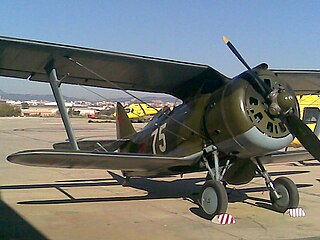
Yevgeny Yakovlevich Savitsky was a Soviet World War II fighter ace who later became a marshal of aviation.

The Byelorussian Military District was a military district of the Soviet Armed Forces. Originally formed just before World War I as the Minsk Military District out of the remnants of the Vilno Military District and the Warsaw Military District, it was headed by the Russian General Eugen Alexander Ernst Rausch von Traubenberg.
28th Guards Leningrad Order of Kutuzov Fighter Aviation Regiment was an aviation regiment of the Soviet Air Forces during the Second World War, the Korean War, and became part of the Russian Air Force after 1991.
The 470th Guards Fighter Aviation Regiment was a regiment of the Russian Air Force. It drew much of its traditions and history from the previous 169th Fighter Aviation Regiment and the 63rd Guards Vilensky Order of Kutuzov Fighter Aviation Regiment of the Soviet Air Forces. These two regiments were active during the Second World War and the post-war period.
The 64th Fighter Aviation Corps was an aviation corps of the Soviet Air Forces. The corps was the parent unit for Soviet interceptor units based in northeastern Manchuria during the Korean War.
The 940th Fighter-Bomber Aviation Regiment was an aviation regiment of the Soviet Air Force. It was formed in 1942 in the Soviet Far East and fought in the Soviet invasion of Manchuria. During the last months of the Korean War, the regiment was relocated to China, but did not fight in combat due to the end of the war. After the end of the latter it was transferred to Belarus, where it served for the remainder of the Cold War, being converted into a fighter-bomber regiment in 1960.

The 149th Mixed Aviation Division was an aviation division of the Russian Air Force.
The 180th Guards Fighter Aviation Regiment was a military unit of the Red Army Air Force, which took part in the fighting of the Great Patriotic War, and then became part of the Russian Air Defence Forces and finally the Russian Air Force.
The 86th Guards Fighter Aviation Regiment was an aviation regiment of the Soviet Air Forces, and after the dissolution of the Soviet Union, the main formation of the Moldovan Air Force.
The 726th Fighter Aviation Regiment was an aviation regiment of the Soviet Air Forces and the Soviet Air Defense Forces.
The 240th Fighter Aviation Division was a fighter aircraft formation of the Soviet Air Forces during World War II. It saw its most eventful actions during that war, and in 1949 became the 119th Fighter Aviation Division.

The 177th Fighter Aviation Regiment PVO was a fighter regiment of the Soviet Air Defense Forces during World War II and the Cold War, later becoming part of the Russian Air Defense Forces and finally the Russian Air Force.
The 176th Fighter Aviation Regiment PVO was a fighter regiment of the Soviet Air Defense Forces during World War II and the Cold War. The unit was disbanded in March 1960.
The 162nd Fighter Aviation Regiment was a fighter regiment (IAP) of the Soviet Air Force during World War II that became part of the Soviet Air Defense Force (PVO) during the Cold War as the 162nd Fighter Aviation Regiment PVO. It was disbanded in 1959 during the reorganization of the PVO.
The 100th Guards Fighter Aviation Regiment as a fighter regiment (IAP) of the Soviet Air Force during World War II and the early years of the Cold War.
The 518th Fighter Aviation Regiment was a fighter aviation regiment of the Soviet Air Forces during World War II that became part of the Soviet Air Defence Forces after the end of the war.
The 712th Guards Fighter Aviation Regiment is a fighter aviation regiment of the Russian Air Force. Part of the 21st Mixed Aviation Division of the 14th Air and Air Defense Forces Army, the regiment is based at Kansk air base and flies the Mikoyan MiG-31BM.

The 120th Fighter Aviation Regiment was a fighter aircraft regiment of the Soviet Air Forces, formed twice in 1940 and 1969.
The 6th Guards Don-Szeged Red Banner Order of Suvorov Fighter Aviation Division was a fighter aviation division of the Soviet Air Force during World War II and the Cold War. The division was formed in early 1943 from the 268th Fighter Aviation Division, which distinguished itself in the Battle of Stalingrad. After the end of the war, the division was stationed in East Germany from 1951 to the end of the Cold War.
The 3rd Guards Iasi Order of Suvorov Fighter Aviation Corps was an aviation corps of the Soviet Air Force formed during World War II. The corps was formed in December 1942 as the 4th Fighter Aviation Corps and received Guards status in July 1944. Postwar, the corps was renumbered as the 72nd Guards Fighter Aviation Corps and transferred to the Soviet Air Defense Forces. It was reorganized as an air defense division in 1960.






